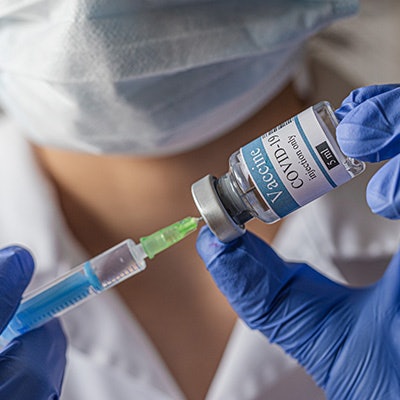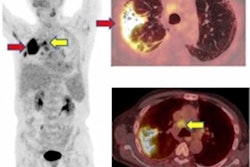
Abnormal PET radiotracer uptake in lymph nodes that can mimic malignant cancer is more common in patients who have had the second dose of the Moderna COVID-19 vaccine, according to research published June 10 in JAMA Oncology.
Researchers from Yale University analyzed all FDG-PET/CT scans from cancer patients at their academic medical center who had received COVID-19 vaccines and found a significant number developed inflammatory immune responses in ipsilateral axillary lymph nodes that could mimic or mask malignant cancer for up to 32 days.
"Ipsilateral axillary nodal reactivity is commonly seen after the intramuscular administration of the COVID-19 mRNA vaccines, more so after the second dose than after the first, and more commonly with the Moderna than the Pfizer vaccine," wrote clinical fellow Dr. Mehmet Adin of Yale School of Medicine in New Haven, CT.
Previous studies have reported intramuscular COVID-19 vaccinations may induce ipsilateral axillary lymph node reactivity that may be falsely attributed to malignant abnormality. This finding may prompt unwarranted interventions, or it may be falsely attributed to vaccination rather than cancer, which could delay care, according to the authors.
In this study, the researchers sought additional evidence on the link between Moderna and Pfizer COVID-19 vaccines and nodal reactivity. They screened 1,290 patients who had FDG-PET/CT scans between December 11, 2020, and March 1, 2021, at the Yale New Haven Hospital and identified 68 who had received at least one dose of a COVID-19 vaccine. All but one of the patients underwent PET/CT for oncologic indications, none of which were for adenopathy ipsilateral to vaccination sites.
The intensity of lymph node activity was graded by Deauville criteria, a scale based on visual interpretation of FDG uptake that rates FDG-avid lesions on a scale from 1 (no uptake) to 5 (markedly increased uptake). Activity more intense than mediastinal blood pool was considered reactive.
Lymph node activity tended to occur at higher rates for individuals who received the Moderna vaccine compared with Pfizer, in both rounds of administration.
| Rates of lymph node activity on FDG-PET scans after COVID-19 vaccination | |||
| Both vaccines | Pfizer vaccine | Moderna vaccine | |
| First vaccine dose | 5% | 3% | 10% |
| Second vaccine dose | 26% | 15% | 57% |
"Increased nodal FDG uptake, presumably from an inflammatory immune response to the vaccine, was observed up to 32 days after vaccination in this cohort, harboring the potential risk of mimicking or masking malignant disease," the authors wrote.
The finding corroborated evidence from another recent study that suggests FDG-PET/CT scans may confound image interpretation for up to 24 days in cancer patients who have received a COVID-19 vaccine.
In addition, the study found women were more likely to develop reactive nodes, which is an important implication for breast cancer imaging concordant with a statement issued by the Society of Breast Imaging, according to the authors.
Adin and his colleagues at Yale suggest patients who have cancer with a propensity for spread to ipsilateral axillary lymph nodes -- primarily breast cancer, melanoma, and lymphomas -- should have the COVID-19 vaccine administered in the axilla contralateral to the previously or potentially involved site. Also, nuclear medicine technologists should document the vaccine site, date, type, and whether the patient has received the first or second dose.
The authors noted one limitation: This was a single study at Yale School of Medicine with a limited sample size and follow-up during the early COVID-19 vaccination stage.
"However, the study was conducted by strict and reproducible PET and CT criteria, and provides a framework for the future studies in this field," they concluded.




















